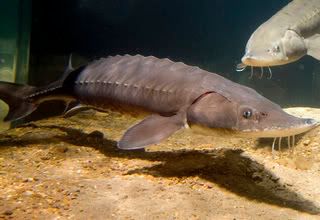
Think the 3-foot long lungfish with a 100-year lifespan isn’t enough? Howzabout the Lake Sturgeon (Acipenser fulvescens), right here in the Midwest, which, during its life of 150 years, can grow to 8 feet long. It has gigantic bony plates on its body, which grow smoother as it ages, because small spiky fish aren’t as digestible. The name “sturgeon” means “the stirrer” in various European languages (and, its scientific name means “reddish-yellow sturgeon” in Latin), which refers to its bottom-feeding habits. The “whiskers” (more technically barbules, which translates from Latin to… uh… whiskers) on their snout allow them to feel food items, such as crustaceans and small fish that are hiding under the substrate, which they suction up with their protruding mouth. Sound familiar?
As stated in the lungfish and tuatara posts, long life means one thing in the animal kingdom: slow to reproduce. Sturgeons take just as long to go through puberty as we do, reaching sexual maturity at 15 to 25 years of age, though they probably don’t have to worry about strange hair and cracking voices, what with being fish and all. Slow to reproduce means that this big fish is still getting over being used for meat, caviar, and isinglass (whatever that is). Pollution, damming, and the normal ol’ endangering factors still come into play.
Since this big bony fish has become protected in pretty much all of its range, the population has stabilized, even bumping it off the IUCN Redlist. It’s very much on its way to become one of those “Conservation Success Stories” like the bald eagle, but hopefully, when it’s pulled of the state endangered species lists, it gets some media attention too.





No comments:
Post a Comment